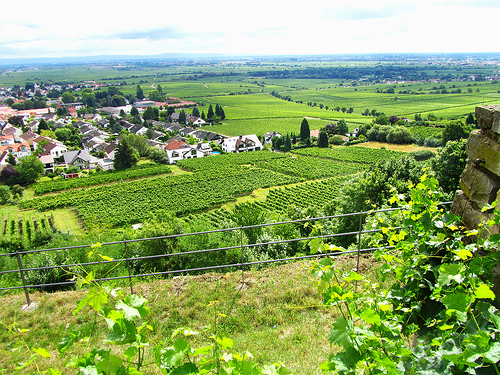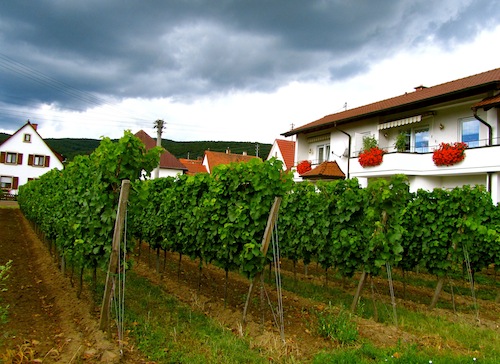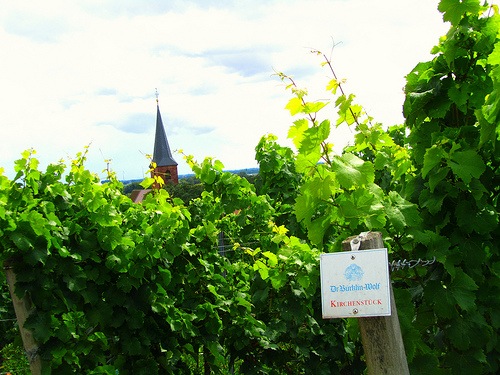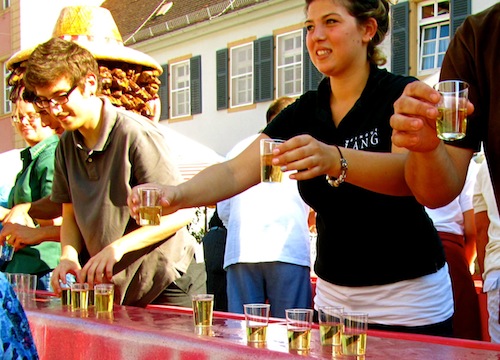
In one respect, the Palatinate (the southwestern corner of Germany) is a lot like Iowa: it has one crop and one crop only that dominates the countryside, local business, people's minds and people's fears.
Luckily for the Palatinate, this crop is wine.
The local growers -- concentrated mainly in the east of the region -- produce a lot of the stuff: 250 million litres every year, enough to provide every man, woman and child in the Palatinate with half a litre every day. That might help to explain why the locals are always so cheerful.
Stroll through the countryside, and you will not see a different crop for hours. No wheat, no potatoes and certainly no corn. Vines grow next to the hiking trails, stretch out in the valley below and cover the slopes of the distant hills.

Wine, wine, everywhere...

...even in the back gardens of ordinary residential homes.
Towns in the Palatinate have wine bars where towns in the rougher North of Germany would have pubs, and even rather dingy restaurants have a wine card with five or six different offerings.
On our walks, we came across a town called Forst, which is basically just a single row of buildings, a thin strip exactly one street wide between a busy highway and the forest, consisting of a church and half a mile of handsome 200-year old winery estates.
Step across the road to roam through the vineyards that are neatly divided and sub-divided into individual parcels with historical names such as "Jesuits' garden" and "Church orchard," pick your favorite and buy a bottle or two when returning into town. (Or have them right there, in one of the vineyards' restaurants. Just make sure that there is somebody around who can ferry you back to your hotel.)

Peoples' lives everywhere in the Palatinate are dominated by wine, even the lives of people who are not working in the wine industry. In bad years, the vineyard workers may not receive their usual bonuses and have to cut down on their expenses, and the vineyard owner will delay his plans of building an annex to his cellars or of expanding his hotel operation -- and everybody suffers.
This explains the hysteria that greets the prospect of anything going seriously haywire during the wine-growing season. In May 2012, when an unseasonably late frost threatened to kill off substantial numbers of vines, the entire province went essentially gaga. Fires were burnt at night, and helicopters were made to hover above the vineyards for hours on end to prevent the hot air from escaping. When it turned out that the damage had been far less serious than feared, you could hear the sigh of relief throughout the entire region.
But wine plays an even more important role in peoples' lives when the living is easy. There are literally hundreds of wine festivals in the area, all the way from February to November, and every local has a brochure with a list that features all of them because in the busy months of the late summer and early fall, five or six may coincide on the same weekend. (Look here for this summer's dates; the list is in German, but I am sure you will get the drift.)

The biggest of all of these -- the "largest wine festival in the world", no less -- is staged annually in Bad Dürkheim. On the second and third week-ends of September, more than 600,000 people invade this peaceful spa town (pop.: 20,000) for the Wurstmarkt, whose rules have remained largely unchanged for 500 years -- only 36 vineyard owners are allowed to operate separate booths where they serve their wine together with local food specialties.
This is a jealously guarded privilege that is passed on from generation to generation. The vineyard owners only lose this privilege if the city council has established that the vineyard owner sold wine that they have not produced themselves, subsequent to which they will be tarred, feathered and put in the stocks (I exaggerate, but only mildly).
On the narrow benches of the Schubkärchler -- which is what the booths are called -- you are certain to meet "friends you've never met before": at least that's what everybody in the Palatinate always says, so it must be true.
Bad Dürkheim can be easily reached through the suburban train networks of the near-by industrial cities of Mannheim and Ludwigshafen. If you are there on a business trip and are looking for something to do on a day between meetings, just hop on that Strassenbahn: the idyllic garden of the Palatinate is less than an hour away.

To learn more about the Palatinate, visit their website Hiking in Romantic Germany or follow Easy Hiker's series on Facebook.